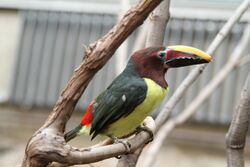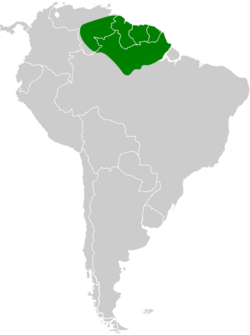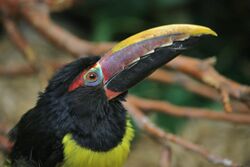Biology:Green aracari
| Green aracari | |
|---|---|

| |
| Female at Philadelphia Zoo, Pennsylvania, USA | |
| Scientific classification | |
| Domain: | Eukaryota |
| Kingdom: | Animalia |
| Phylum: | Chordata |
| Class: | Aves |
| Order: | Piciformes |
| Family: | Ramphastidae |
| Genus: | Pteroglossus |
| Species: | P. viridis
|
| Binomial name | |
| Pteroglossus viridis (Linnaeus, 1766)
| |

| |
| Synonyms | |
| |
The green araçari (Pteroglossus viridis), is a toucan, a near-passerine bird. It is found in the lowland forests of northeastern South America (the Guiana Shield), in the northeast Amazon Basin, the Guianas and the eastern Orinoco River drainage of Venezuela. At 30–40 cm. (12–16 in) long and weighing 110–160 grams (3.9–5.7 oz.), it is the smallest aracari in its range,[3][4] and among the smallest members of the toucan family.
Taxonomy and systematics

The green aracari was originally classified in the genus Ramphastos. The species is named for the green feathers covering its back.
Description
Males' crowns are black, while females' are reddish brown.[5]
Behaviour and ecology
Breeding
Breeding occurs from February to June. It nests in tree cavities, producing 2–4 white eggs.[6] The parents cooperate in rearing their young.[5]
Food and feeding
Its diet consists mostly of fruit, including the fruits of Cecropia trees and the palm Oenocarpus bacaba.[6] The serrated edges of the green aracari's large bill help the bird to grip and gather fruit. Insects are also an occasional part of the diet, giving the birds protein.[5]
Pets
In captivity it is the most frequently bred member of the toucan family and is the most popular as a tame hand-fed pet. It requires a large cage and toys to prevent boredom due to its active nature, and a high-fruit diet. When all these requirements are met it is an affectionate companion for many years.[citation needed]
References
- ↑ BirdLife International (2016). "Pteroglossus viridis". IUCN Red List of Threatened Species 2016: e.T22681994A95210922. doi:10.2305/IUCN.UK.2016-3.RLTS.T22681994A95210922.en. https://www.iucnredlist.org/species/22681994/95210922. Retrieved 12 November 2021.
- ↑ "Appendices | CITES". https://cites.org/eng/app/appendices.php.
- ↑ Steven L. Hilty (2003). Birds of Venezuela (Princeton Paperbacks). Princeton, N.J: Princeton University Press. pp. 460. ISBN 0-691-09250-8.
- ↑ "Ramphastidae (Toucans, Toucanets, & Aracaris)". http://www.nashvillezoo.org/piciformes/ramphastidae.htm.
- ↑ 5.0 5.1 5.2 "Green Aracari Fact Sheet, Lincoln Park Zoo"
- ↑ 6.0 6.1 Lester L. Short and Jennifer F. M. Horne; colour plates and line drawings by Albert Earl Gilbert (2001). Toucans, barbets and honeyguides: Ramphastidae, Capitonidae and Indicatoridae. Oxford [Oxfordshire]: Oxford University Press. pp. 370–372. ISBN 0-19-854666-1. https://books.google.com/books?id=EMEKaTlR3qcC&pg=PA370. Retrieved 2012-04-10.
External links
- Green aracari videos on the Internet Bird Collection
- Stamps[Usurped!] (for Guyana, Suriname) with ~RangeMap
- Green aracari photo gallery at VIREO (Drexel University)
- Photo-Medium Res; Article nashvillezoo—"Ramphastidae"
- Photo-High Res; Article & synopsis w/systematics arthurgrosset
Wikidata ☰ Q1067850 entry
 |


